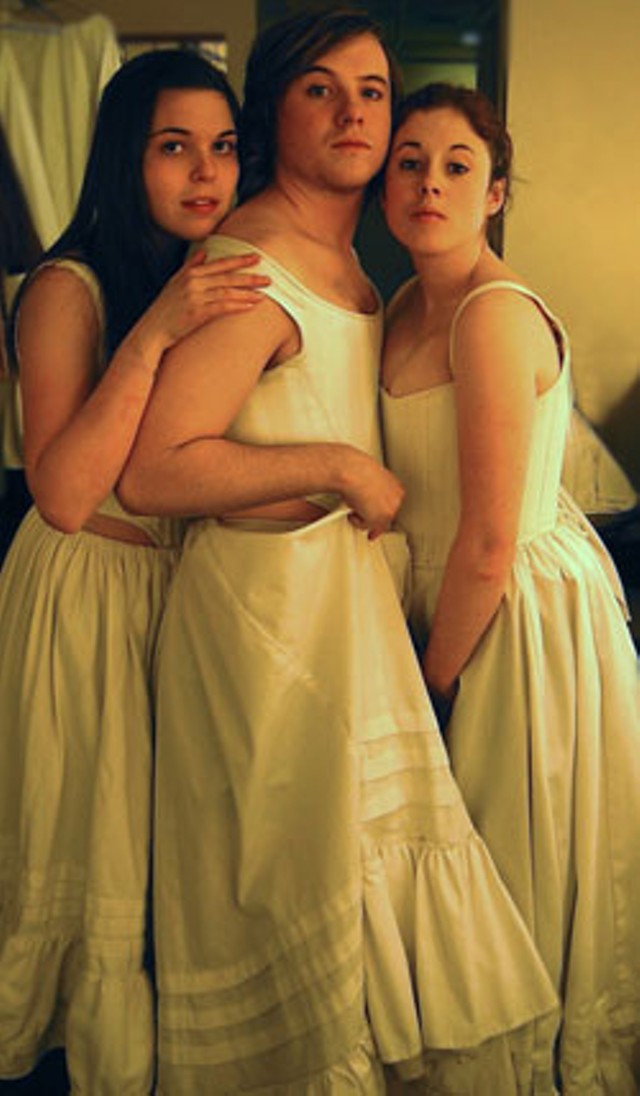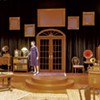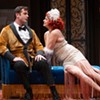Published February 27, 2008 at 5:44 a.m.
Every good play should pose a central provocative question. Occasionally, the dialogue states it directly; more often, it arises as the story unfolds. In Jeffrey Hatcher’s Compleat Female Stage Beauty (1999), the query comes as a parting shot when an affair ends. A 17th-century duke rejects his former lover, an actor unemployable since the king banned men from playing women’s parts. “What we do is what we are,” the duke says cold-heartedly. “Take that away and what are we?”
Does work define identity, especially for passionate, ego-driven artists? What happens when an entire profession vanishes overnight? Issues of gender identity and sexual orientation allow Hatcher to explore several intriguing dimensions of his central theme. Because the play bursts with so many ideas, the script sprawls a bit. But it also bustles with comedic energy, dramatic tension and a trove of fascinating characters — a meaty, witty offering befitting its rambunctious period setting.
Compleat Female Stage Beauty takes place in Restoration England, which the playwright has peopled with re-imagined versions of actual historical figures. In the script, diarist Samuel Pepys serves as a character and occasional narrator, describing his era’s cultural renaissance. When Charles II returned from exile in 1660, he eagerly revived London’s artistic world, which had been suppressed for nearly two decades during the reign of Oliver Cromwell’s iron-fisted Puritanism.
As in the theater of Shakespeare’s day, men continued to perform all the roles. Charles II soon issued an edict upending this: Women were to play the female parts, and men were forbidden to do so. Stage Beauty’s central character is actor Edward Kynaston, once considered “the most beautiful woman in the house,” according to Pepys. In a 2004 interview, Hatcher recounted how he fashioned the fictional Kynaston from biographical shards. The available information was “just tantalizing enough to give me the bare bones, and then I was able to build around it,” he recalled.
The play opens with Kynaston in his signature role as Desdemona in Shakespeare’s Othello. It makes him the toast of the town. Yet he knows something is missing in his performance of the pivotal death scene, even if it brings the house down every night and turns society ladies into giggling backstage groupies. He flirts with, but fends off, frisky suitors of both sexes, including the odious Sir Charles Sedley, who mistakes Kynaston — still in costume — for a whore in the park.
But the actor gives himself freely to his lover, the Duke of Buckingham. The Duke, however, insists that Kynaston wear one of his character’s flowing wigs when their assignations take place in the theater’s onstage bed. Kynaston’s faithful dresser, Maria, who accidentally spies the men in flagrante one night, harbors a secret crush on her boss, as well as hidden acting ambitions.
Meanwhile, in another theater, Mrs. Margaret Hughes makes an underground premiere as Desdemona, becoming the first woman to act on the English stage.
Several palace scenes show the free-spirited relationship between Charles and his buxom teenaged mistress, Nell Gwynn. They stage racy royal entertainments for their own amusement, and Nell’s own acting aspirations catalyze the king to issue the female-friendly edict. When Kynaston finds his profession — and his stardom — instantly extinguished, his life spirals quickly downward. Sedley becomes Hughes’ ardent patron, and exacts further revenge on Kynaston by having thugs beat him half to death. The Duke spurns his broken lover.
Kynaston attempts male roles, but finds he has trained away his masculinity. He begs the King for permission to return to what he knows: “There are things I can be as a woman that I cannot be as a man.” His plea is rebuffed, and the once-lauded actor is ultimately reduced to singing bawdy songs for drunk tavern patrons. His path from humiliation to redemption is unusual and touching. He spars with the women who prod him along the way: Maria, Nell, Hughes and Desdemona, whose death scene he finally gets right.
In the University of Vermont Department of Theatre’s current production, several major problems with Sarah Carleton’s direction gave actors unnecessary hurdles to overcome. Acoustics at the Royall Tyler are less than ideal — the cavernous ceiling tends to swallow dialogue. The set for Stage Beauty featured two large playing areas and Jeff Modereger’s usual assortment of visually inspired details, such as roughhewn posts and beams. But Carleton rarely used the space closest to the audience, where Hatcher’s delicate repartee would have been easier to hear. That expanse of wood sat curiously bare, used only for repeated cast entrances and exits via the theater’s aisles. The tromping up and down the stairs was loud and time consuming, and served no artistic purpose; instead, it dragged out the already long running time.
Overall, the direction seemed rather static; Carleton gave her actors very little to do, in terms of places to move on stage, props to manipulate, gestures to manifest their feelings, or ways to interact physically with each other. This flatness muted the lively settings and seductive themes. It fought against the winsome energy of the youthful actors, clad elegantly in Martin A. Thaler’s shiny, exquisitely detailed period costumes.
In spite of this, Adam Yeager Gould gave a nuanced, stirring performance in the demanding role of Kynaston. He sensitively showed how his character’s comfortable, lighthearted fluidity in moving between gender roles disintegrates into a desperate interior struggle when circumstances change. Especially impressive were the subtle ways he expressed his character’s identity battle: altered speech patterns, hesitant body language, even making or failing to make eye contact with other characters. Gould’s imminent graduation is a loss to the UVM stage, but a gain to the pro ranks, where he’s headed.
Jenn Staples made Nell Gwynn a refreshing tonic of comic energy. Staples embraced the profane pixie’s spirit of bawdy fun, strutting happily in her nearly naked costumes and dropping every “h” in her Cockney accent. As King Charles, Edward Nagel was a worthy foil to Staples’ friskiness — slightly phlegmatic from age and breeding, but game for a good time. Nagel managed to convey the hauteur of His Highness even while wearing an extravagant ball gown.
For the film version of Stage Beauty, Hatcher combined the somewhat underwritten roles of Maria and Hughes, creating a more compelling counterpart for Kynaston. Both Hayley Smith as Maria and Jana Pollack as Margaret Hughes could have benefited from better directorial input to flesh out their parts. Smith did demonstrate Maria’s unrequited longing for Kynaston, rendering the intimate scene near the end of Act II with refreshing innocence. Pollack’s performance remained on the surface, however. She emoted her way through the dialogue, rather than using gesture and expression to show what her character felt inside.
The performer worst served by Carleton was Bretton John Reis as Sir Charles Sedley. By saddling him with a crippling lisp, ludicrous dandy’s get-up (fuchsia breeches!) and whiteface makeup, she drained Sedley’s villainy and softened his character’s impact. In a play about subtle and blurred lines of sexual orientation, this odd interpretation came off as a crude caricature of an outdated gay stereotype.
Despite the poor direction, the students’ excellent work in Hatcher’s intriguing play made Stage Beauty well worth seeing. A host of supporting actors turned in fine performances, Richard Hutchinson, Jess Hodge, Nick Hapshe and Will Duane among them. Thaler’s costume crew of 40 turned the actors out in sumptuous Restoration finery, down to the details of red-heeled men’s shoes. And Gould is an actor about whom you’ll want to say someday, I saw him when . . .
Info:
Compleat Female Stage Beauty, directed by Sarah E. Carleton, produced by University of Vermont Department of Theater. Royall Tyler Theatre, UVM, Burlington, Thursday to Saturday, February 28 to March 1, at 7:30 p.m., and Sunday, March 2, at 2 p.m. $17.
More By This Author
Speaking of...
-

Executive Director Kurt Thoma Leaves Barre Opera House
Mar 5, 2024 -

Records Show UVM Professors Questioned Decision to Nix Palestinian Writer’s Appearance
Dec 20, 2023 -

UVM Strikes Deal With Burlington That Could House More Students on Campus
Dec 18, 2023 -

Vermonter's Musical Bound for Broadway With Hillary Clinton as a Producer
Oct 25, 2023 -

Burlington Area Selected as Semiconductor 'Tech Hub'
Oct 25, 2023 - More »
Comments
Comments are closed.
From 2014-2020, Seven Days allowed readers to comment on all stories posted on our website. While we've appreciated the suggestions and insights, right now Seven Days is prioritizing our core mission — producing high-quality, responsible local journalism — over moderating online debates between readers.
To criticize, correct or praise our reporting, please send us a letter to the editor or send us a tip. We’ll check it out and report the results.
Online comments may return when we have better tech tools for managing them. Thanks for reading.














































